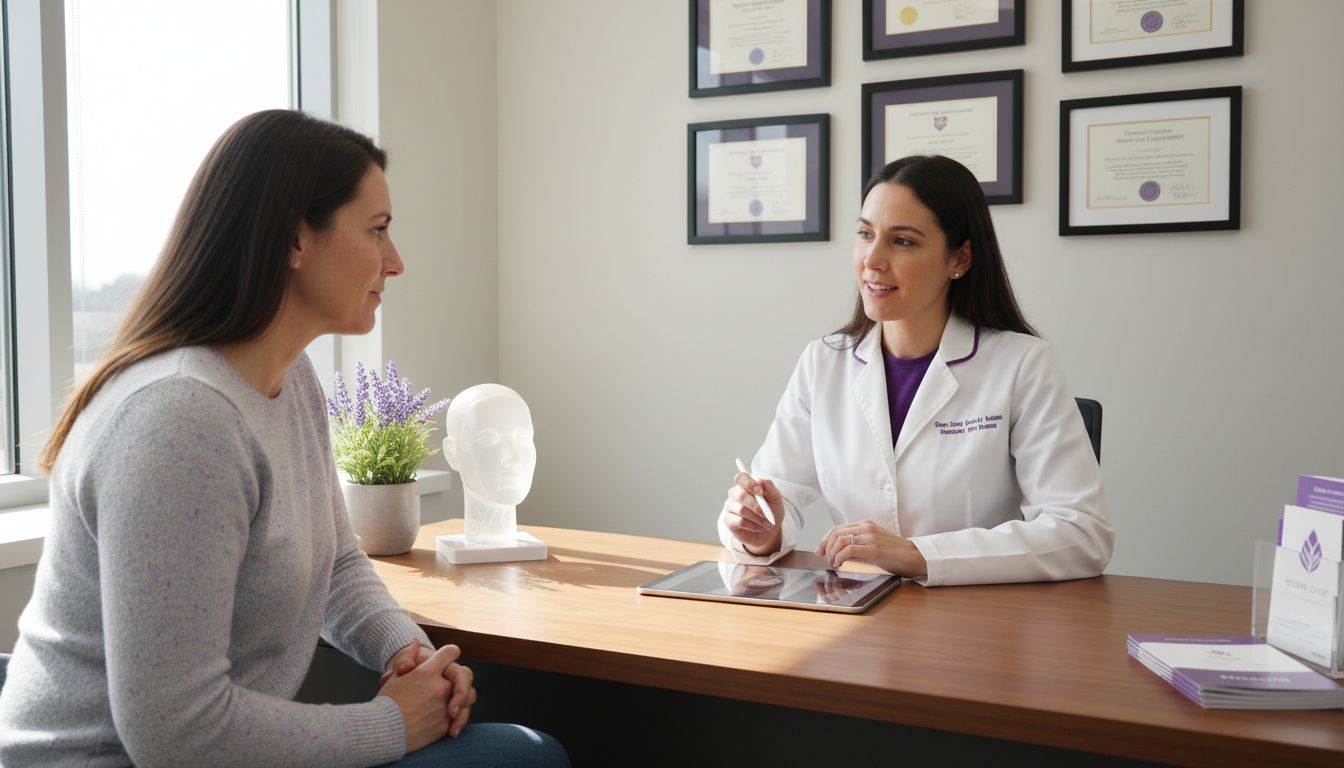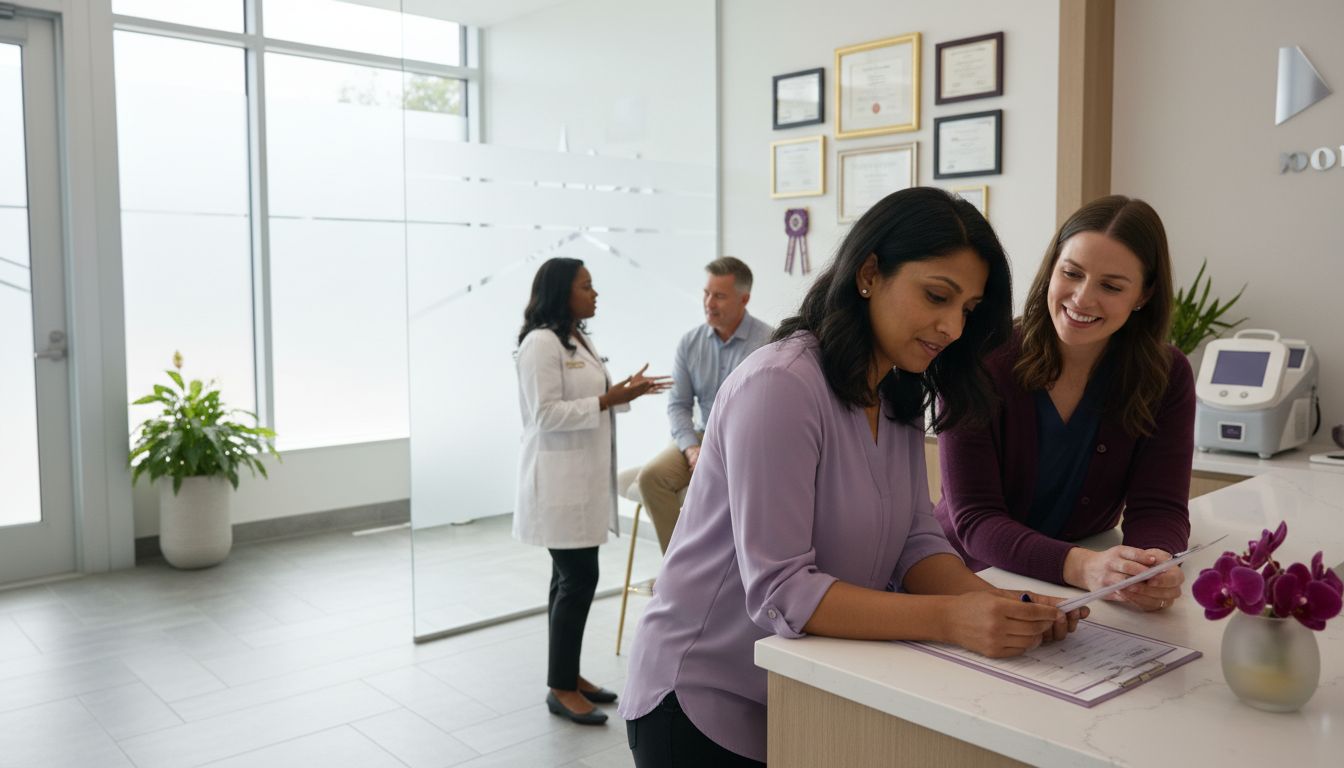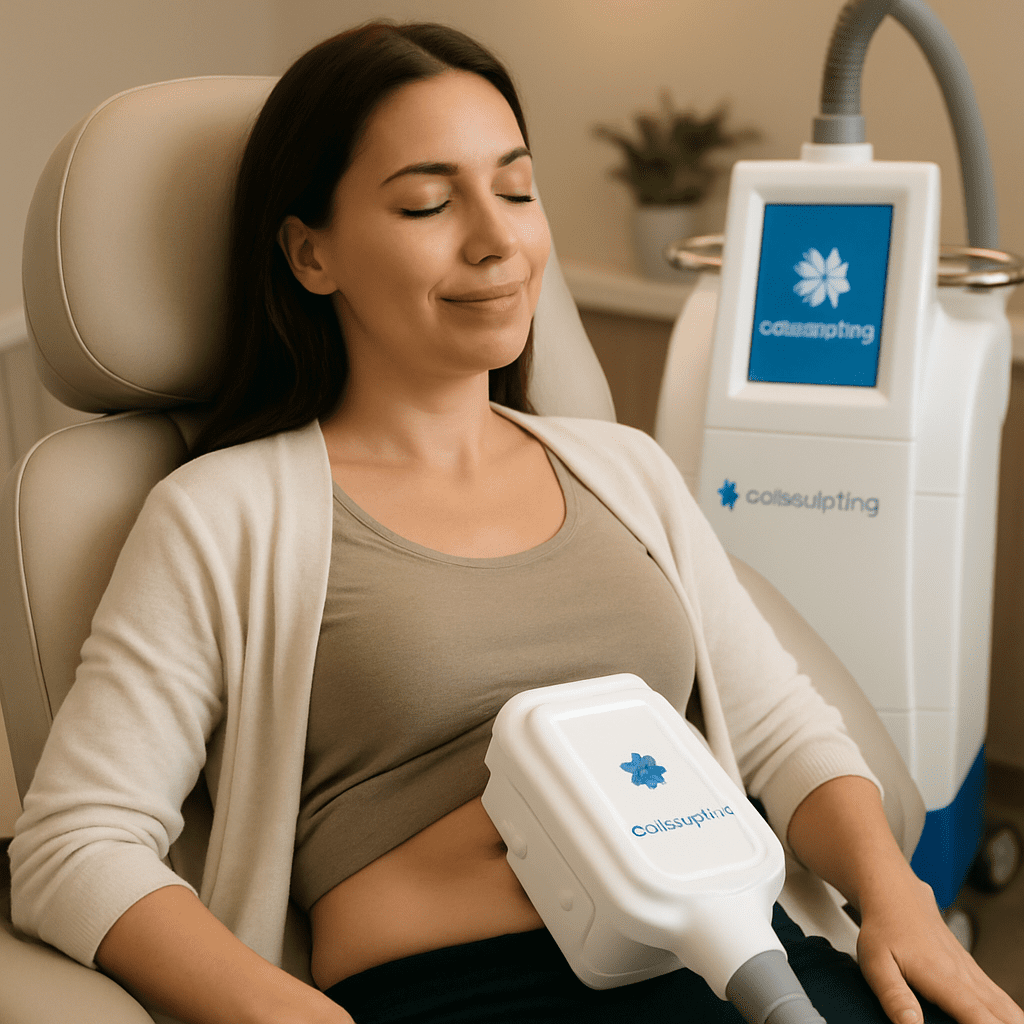Acne scars carry hidden weight that goes far beyond what you see in the mirror. For many, these marks become a daily reminder that affects mood, relationships, and self-confidence. Nearly 40 percent of people with acne scars face clinical depression, underscoring just how much emotional pain can hide beneath the surface. Understanding the full impact of acne scars is the first step to real healing—emotionally and physically.
Table of Contents
- Why Acne Scars Matter Emotionally
- Types Of Acne Scars Defined
- How Acne Scars Form And Persist
- Benefits Of Professional Treatment
- Home Vs Clinical Treatment Options
- Preventing And Managing Future Scarring
Key Takeaways
| Point | Details |
|---|---|
| Emotional Impact of Acne Scars | Acne scars can lead to significant psychological challenges, including depression and negative self-perception, affecting social interactions and self-esteem. |
| Types of Acne Scars | Acne scars are mainly categorized into atrophic and hypertrophic scars, each requiring distinct treatment approaches for effective management. |
| Benefits of Professional Treatments | Advanced professional treatments, such as laser therapy and microneedling, offer greater precision and long-term results compared to at-home remedies. |
| Preventive Strategies | Proactive management of acne, including early treatment and proper skincare, is essential to minimize the risk of permanent scarring. |
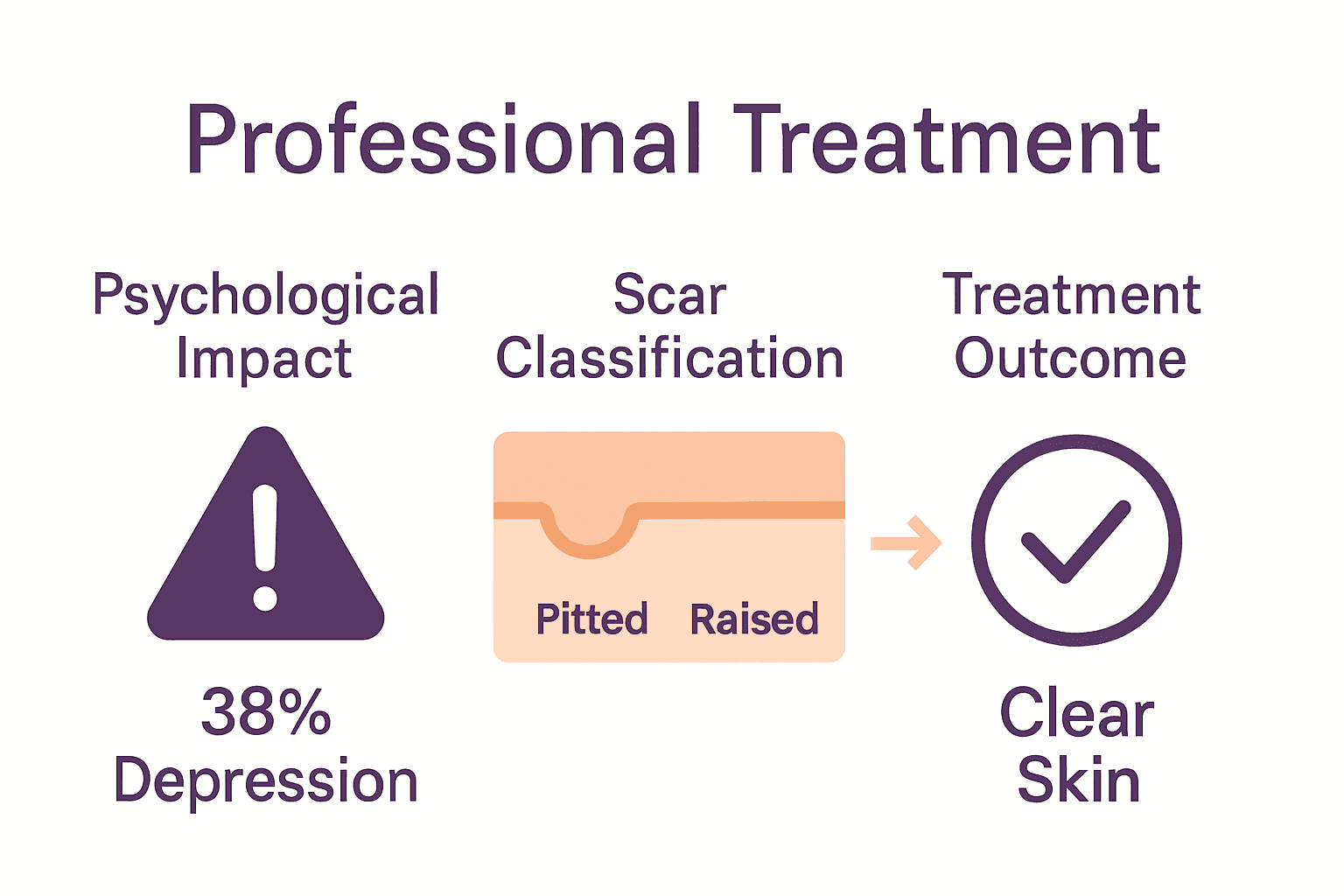 |
|
Why Acne Scars Matter Emotionally
Acne scars are far more than just surface-level skin imperfections. They represent a profound emotional journey that impacts psychological well-being, self-perception, and social interactions. Emotional scarring often runs deeper than the physical marks themselves, creating complex psychological challenges for those affected.
Research provides stark evidence of the emotional toll. According to a PubMed study, an alarming 38.27% of patients with acne scars experienced clinical depression, with varying levels of severity. More specifically, 18.5% reported moderate depression, while 8.6% encountered severe depressive symptoms. These numbers reveal that acne scars aren’t merely a cosmetic concern but a significant mental health issue.
The social implications are equally distressing. Another multinational study highlighted the profound impact on personal and professional interactions. Approximately 25.7% of participants felt less attractive, and 27.5% experienced embarrassment or self-consciousness about their scars. Even more troubling, 8.3% reported experiencing verbal or physical abuse related to their skin condition. Professional consequences were also evident, with 15.9% feeling unfairly dismissed from work opportunities due to their appearance.
Understanding these emotional challenges is crucial. Acne scars can create a cycle of negative self-perception that extends far beyond skin-deep concerns. They can erode confidence, limit social engagement, and create significant psychological barriers. For many individuals, treating acne scars becomes not just a cosmetic choice, but a pathway to emotional healing and restored self-esteem.
Types Of Acne Scars Defined
Understanding the different types of acne scars is crucial for effective treatment and management. According to PubMed research, acne scars are primarily classified into two major categories: atrophic and hypertrophic scars, each with distinct characteristics and underlying mechanisms.
Atrophic Scars represent the most common type of acne scarring, characterized by a loss of skin tissue. These scars create depressions or indentations in the skin and are further subdivided into three specific subtypes:
- Ice Pick Scars: Narrow, deep puncture-like indentations that resemble small holes
- Rolling Scars: Broad depressions with sloping edges, creating a wave-like texture
- Boxcar Scars: Wider, rectangular depressions with sharper vertical edges
Hypertrophic Scars, in contrast, involve excess collagen production. Unlike atrophic scars, these appear as raised, thickened tissue that grows beyond the original wound boundaries. They are less common but can be equally challenging to treat. These scars typically develop when the body produces too much collagen during the healing process, resulting in a more prominent, raised appearance.
Each scar type requires a unique approach to treatment. Scar removal techniques vary depending on the specific scar characteristics, skin type, and individual healing responses. Understanding these distinctions helps dermatologists and patients develop targeted strategies for improving skin texture and appearance.
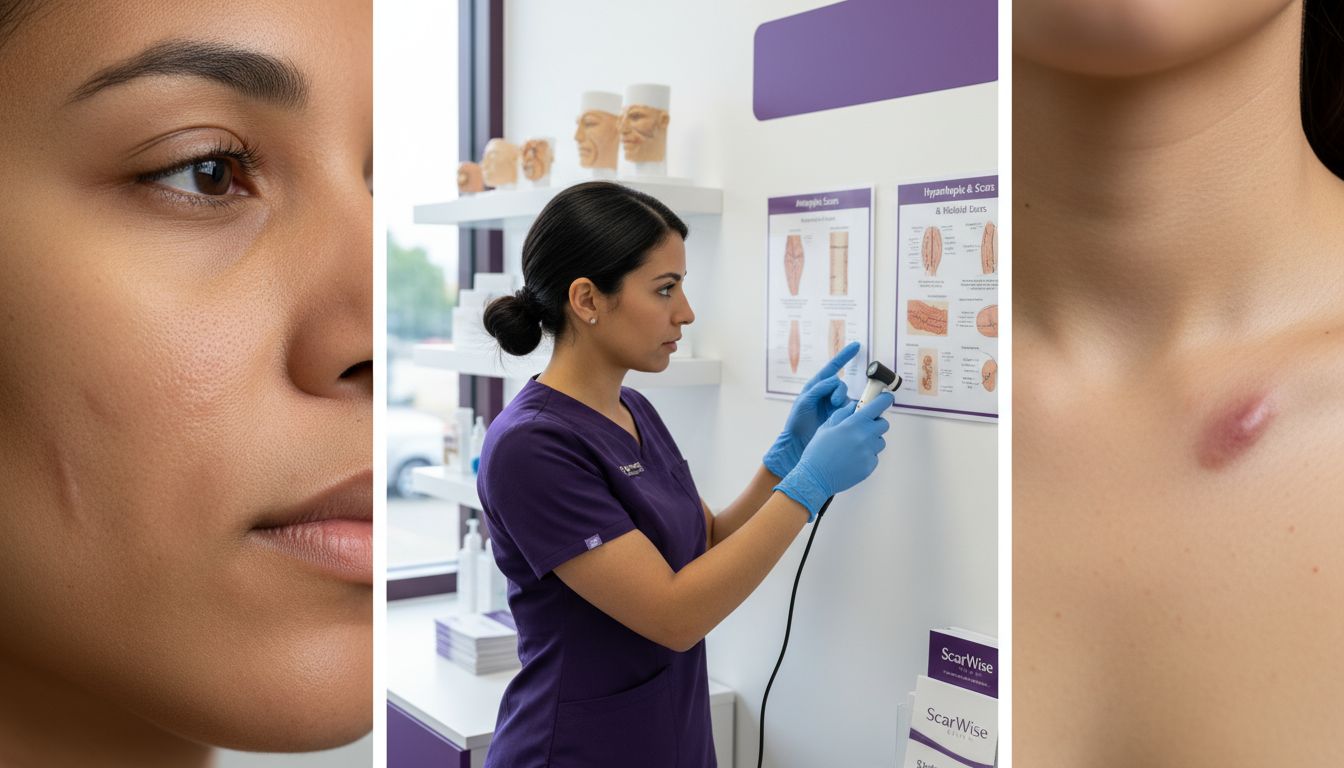
How Acne Scars Form And Persist
The journey from an acne breakout to a lasting scar is a complex biological process involving multiple skin layers and healing mechanisms. According to PubMed research, acne scars emerge from an impaired healing response that occurs following inflammatory acne lesions.
At the core of scar formation are the body’s inflammatory responses. When an acne lesion occurs, the immune system triggers an aggressive healing process. In some individuals, this process goes awry, leading to two primary scar formation scenarios:
- Collagen Degradation: Results in atrophic (depressed) scars
- Excessive Collagen Production: Creates hypertrophic or keloid scars
Several critical factors influence scar persistence and development. Genetic predisposition plays a significant role, determining how an individual’s skin responds to inflammation and healing. The severity of the original acne outbreak is another crucial element. More intense, deeply inflamed acne lesions are more likely to result in permanent scarring.
The body’s natural healing mechanisms can sometimes work against smooth skin recovery. When inflammation damages the skin’s deeper layers, the repair process becomes compromised. Some individuals experience an overactive healing response, producing too much collagen and creating raised scars, while others might experience significant collagen loss, resulting in pitted or indented scars. Scar removal techniques have evolved to address these complex healing variations, offering hope for those seeking to minimize their acne scarring.
Benefits Of Professional Treatment
Treating acne scars isn’t just about cosmetic improvement. Professional treatments offer a scientifically advanced approach to skin restoration that goes far beyond what at-home remedies can achieve. According to PubMed research, professional interventions like laser therapy, chemical peels, and microneedling have demonstrated significant potential in improving skin texture and overall appearance.
The key advantages of professional scar treatment include:
- Precision Targeting: Advanced techniques can address specific scar types with millimeter-level accuracy
- Collagen Stimulation: Treatments directly trigger the body’s natural healing mechanisms
- Comprehensive Skin Rejuvenation: Beyond scar reduction, these methods improve overall skin quality
- Long-Term Results: Professional interventions provide more sustainable improvements compared to topical treatments
Professional treatments work by strategically stimulating the skin’s regenerative processes. Techniques like microneedling create controlled micro-injuries that prompt the body to produce new collagen and elastin. This biological response helps smooth out scar depressions, reduce skin irregularities, and promote a more uniform skin texture. The result isn’t just cosmetic camouflage but genuine skin reconstruction.
Moreover, these treatments offer personalized solutions. Scar removal techniques can be customized based on individual skin type, scar characteristics, and healing potential. By combining medical expertise with advanced technological interventions, professionals can develop targeted treatment plans that address not just the visible scarring, but the underlying skin health and structural integrity.
Home Vs Clinical Treatment Options
Navigating the world of acne scar treatment involves understanding the crucial differences between home remedies and professional interventions. According to Bioderma research, while home treatments can offer some relief, more pronounced scarring typically requires advanced clinical approaches.
Home Treatment Options provide accessible first-line strategies for mild scarring and pigmentation concerns:
- Topical Retinoids: Help accelerate skin cell turnover
- Lightening Creams: Reduce pigmentation and even skin tone
- Over-the-Counter Exfoliants: Gradually improve skin texture
- Natural Remedies: Limited effectiveness but potentially supportive
Clinical treatments, in contrast, offer more profound and targeted interventions. Professional techniques like laser therapy, chemical peels, and microneedling can address deeper skin structural issues that topical treatments cannot reach. These methods work by stimulating collagen production, resurfacing skin layers, and creating controlled healing responses that gradually reduce scar visibility.
The key difference lies in precision and depth of treatment. While home options provide gradual, surface-level improvements, scar removal techniques at professional clinics can transform skin architecture. Trained professionals can assess individual scar characteristics and design customized treatment plans that deliver more significant, long-lasting results than any at-home approach can achieve.
Preventing And Managing Future Scarring
Scar prevention begins with proactive and intelligent acne management. According to Bioderma research, preventing future acne scarring hinges on minimizing inflammation and protecting skin from potential damage during the healing process.
Key Prevention Strategies include:
- Early Acne Treatment: Address breakouts immediately to reduce inflammation
- Sun Protection: Use broad-spectrum sunscreen to prevent hyperpigmentation
- Hands-Off Approach: Never pick, squeeze, or pop acne lesions
- Gentle Skincare: Use non-irritating, non-comedogenic products
- Nutrition: Maintain a balanced diet supporting skin health
Understanding the healing process is crucial. When acne lesions occur, the skin undergoes a complex inflammatory response. By intervening early and supporting the skin’s natural healing mechanisms, you can significantly reduce the likelihood of permanent scarring. This means seeking professional advice at the first signs of persistent or severe acne, rather than waiting for scars to develop.
The most powerful prevention technique is a holistic approach. Scar removal techniques are most effective when combined with proactive skincare. This involves maintaining consistent skincare routines, managing underlying factors like hormonal imbalances or stress, and treating acne comprehensively before it can cause lasting damage to your skin’s structure and appearance.
Take Control of Your Skin and Confidence Today
Acne scars can deeply impact your self-esteem and emotional well-being as the article explains. If you are struggling with depressed or raised scars that affect how you feel about your appearance professional help offers a meaningful path to healing. At Simcoe Cosmetic Clinic, we provide targeted scar removal techniques tailored to your unique skin type and scar characteristics helping restore smoothness and boost confidence.

Don’t let scars hold you back any longer. Visit our website https://scclinic.ca now to explore our customized treatments that promote real skin improvement. Take the first step by booking a consultation to develop a personalized plan that can transform your skin and restore your self-assurance. Every day you delay is another day lost from revealing your true glow.
Frequently Asked Questions
What emotional impacts can acne scars have on an individual?
Acne scars can significantly affect psychological well-being, self-perception, and social interactions, leading to issues like depression, anxiety, and low self-esteem. Studies have shown that nearly 38.27% of individuals with acne scars experience clinical depression.
What are the main types of acne scars, and how are they different?
Acne scars are mainly categorized into atrophic and hypertrophic scars. Atrophic scars result from tissue loss and include ice pick, rolling, and boxcar scars. Hypertrophic scars, on the other hand, are raised scars caused by excess collagen production during healing.
How can professional treatments improve the appearance of acne scars?
Professional treatments such as laser therapy, chemical peels, and microneedling can provide targeted interventions that stimulate collagen production, improve skin texture, and promote overall skin rejuvenation, leading to more sustainable results than home remedies.
What preventive measures can be taken to avoid future acne scarring?
To prevent future acne scarring, it’s important to treat breakouts early, protect the skin from sun exposure, avoid picking at lesions, use gentle skincare products, and maintain a balanced diet that supports skin health.
Recommended
- How to Treat Acne Scars at Home: A Comprehensive Step-by-Step Guide – SIMCOE COSMETIC CLINIC
- Scar Removal Barrie: Effective Treatments and Expert Tips for Smooth Skin – SIMCOE COSMETIC CLINIC
- Effective Acne Treatment in Barrie: Your Complete Resource for Clearer Skin – SIMCOE COSMETIC CLINIC
- How to Reduce Acne Scars with Microneedling Treatment Barrie: A Step-by-Step Guide – SIMCOE COSMETIC CLINIC


